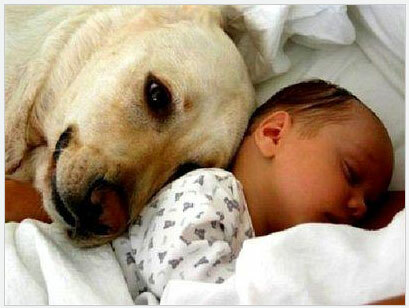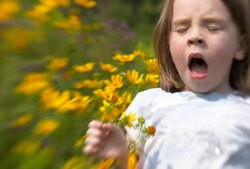Reduction of the body's immune forces leads to a disruption in the regulation of the antibody formation process. As a result, antibodies are formed on some biologically insignificant antigens, in particular, on house dust.
These IgE antibodies are adsorbed to mast cells that contain granules with histamine. Histamine increases the permeability of the vessel wall and expands its lumen. The free end of the antibodies is complementary( comparable) to the molecule or part of the dust molecule. And as soon as the dust( allergen) meets with IgE, attached to the mast cell, triggers the mechanism of degranulation of mast cells, that is, the release of histamine into the environment. This leads to the expansion of the vessels and the release of the transudate through the wall into the intercellular space. Clinically, this is manifested by hyperemia( redness) of the skin and its edema, up to the edema of Quincke. Edema of bronchial mucosa and increased secretion in them leads to bronchospasm, which is expressed clinically by inspiratory dyspnea( with difficulty breathing).
The most dangerous forms of manifestation of allergic reactions are anaphylactic shock and Lyell's syndrome.
With anaphylactic shock, most of the liquid part of the blood passes into the intercellular space due to a massive release of histamine. The arterial pressure drops, the person loses consciousness, the general condition worsens up to a lethal outcome.
Lyell's syndrome is characterized by the fact that after the introduction of any drug into the human body, its skin is almost completely covered with flat bubbles, shorter in a few hours, they are opened or torn when they are pressed with a finger. This condition can also be fatal.
Symptoms of dust allergy
Dust is a collective concept. It consists of many different microscopic elements with a diameter of about 200 microns in all that you have at home. Dust also contains many different organic compounds, such as cells of the desquamated epithelium, food remnants and the like. Soprophy feed on these substances and release their waste into the same dust.
Each of these dust elements is an allergen. Therefore, allergy to dust is so common among the population( about 40%).
Suspicion of an allergy to dust can occur if it occurs only at home, especially when cleaning in the house. In the fresh air, the clinical manifestations quickly pass and do not arise any more until coming back to the house.
The manifestation of allergic reactions in children to dust can be varied.
 Allergic leaf in the form of redness, swelling, with severe itching may appear on the skin. This rash appears suddenly and just as quickly passes after taking antihistamines or stopping the allergen. Running allergic reactions can small concentrations of allergens, but their high concentrations significantly exacerbate the manifestation of clinical manifestations.
Allergic leaf in the form of redness, swelling, with severe itching may appear on the skin. This rash appears suddenly and just as quickly passes after taking antihistamines or stopping the allergen. Running allergic reactions can small concentrations of allergens, but their high concentrations significantly exacerbate the manifestation of clinical manifestations.
On the part of the bronchopulmonary system, a child may experience inspiratory dyspnea, a low-yielding cough with scanty viscous mucous sputum. That is, there is a clinic for bronchial asthma. Bronchodilators( salbutamol, berotek, berodual) stop this condition. Sometimes asthma can be mistaken for bronchitis and then treatment will not be prescribed correctly, and therefore, will not be effective.
Rhinitis and conjunctivitis are probably the most frequent manifestations of dust allergy in a child.
Rhinitis begins with itching of the nasal mucosa and the expulsion of mucus from it in large quantities. Itching leads to frequent sneezing, which does not bring relief.
Conjunctivitis also manifests itself as lacrimation and sensation of a foreign body in the eye. Over time, the eyes are enlarged capillaries, they turn red. This is further aggravated by combing the eyes.
Treatment of dust allergy in children
First you need to reduce the amount of dust in the house as much as possible. Usual vacuum cleaners remove large accumulations of dust, but do not eliminate it completely. In order to fight dust, as with microscopic allergens, you can use vacuum cleaners with HEPO filters.
It is necessary to try to replace the furniture with fabric upholstery on the leather, curtains on the blinds, carpets on the linoleum, use more synthetic materials.
Wet cleaning must be carried out daily, wash clothes and bed linen at least once every 3-4 days.
Drug treatment is performed according to the doctor's prescription.
The use of antihistamines is pathogenetically justified in any form of allergic manifestations. In addition, symptomatic treatment is prescribed. With rhinitis - nasal drops of naphthyzin, with conjunctivitis - eye drops, with asthma - bronchodilators.
Video: Dust
 Allergy to dust in children occurs due to decreased immunity.
Allergy to dust in children occurs due to decreased immunity.



